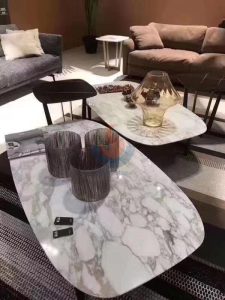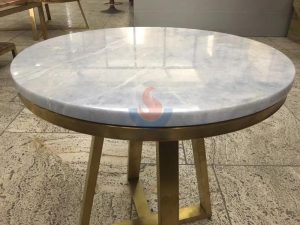In the decoration world, marble has always been a classic choice for its unique texture and noble appearance. However, many people may know little about the chemical corrosion resistance of marble. Practically, especially in settings like kitchens and labs where chemical compounds could be exposed, marble’s corrosion resistance is quite crucial. This page will walk you through the chemical corrosion resistance of marble in detail, expose its performance in the face of many chemicals, and offer some doable maintenance advice. Let’s unveil the mystery of marble’s chemical corrosion resistance together!

Polished Italian Calacatta Altissimo Gold Marble
Marble’s chemical composition and mechanism of corrosion
Marble is mainly composed of calcite (calcium carbonate), a mineral that gives it its unique luster and texture. Marble’s chemical makeup, however, is what makes it susceptible to particular compounds. Strong acids easily react with calcium carbonate to produce surface corrosion or discolouration. Therefore, when marble encounters acidic substances, some chemical reactions may occur, such as acid corrosion and color variation.
Impact of acidic elements
Marble responds most obviously to acidic compounds. For instance, the acidic elements in some detergues, vinegar, or lemon juice could react with calcium carbonate on the surface of marble to etching and surface discoloration results. Especially in the case of long-term contact with acidic substances, the glossiness of the marble surface will be seriously affected, and even pits or cracks may appear on the surface.
Effect of alkaline substances
Marble is rather resistant to alkaline compounds relativewise. However, although the corrosion reaction of marble to alkaline substances is not as severe as that to acidic substances, long-term contact with highly alkaline environments may also cause some changes on the surface. Strong alkaline cleaners, for instance, could destroy the protective layer on Marble’s surface, therefore compromising its look and service life.
Effect of solvents
Marble usually performs well when facing organic solvents (such as alcohol and paint thinners), but these solvents may also have some effects on the marble surface if used improperly. Some solvents, for instance, could produce minor discoloration or patches on the marble surface. Use these solvents thus, try to prevent direct contact with the marble surface and clean it right away.
Marble chemical corrosion resistance tests
Usually, several experimental experiments are needed to better grasp the chemical corrosion resistance of marble. These tests are designed to simulate various chemical environments that marble may encounter in actual use to evaluate its corrosion resistance. Typical tests consist of:
Acid corrosion test
See the surface changes by soaking marble samples in variously concentrated acid solutions. The test will enable us to determine whether, following long-term interaction with acidic compounds, marble will show structural damage or surface etching.
Alkaline corrosion test
Like the acid corrosion test, this one is meant to assess Marble’s performance in an alkaline surroundings. The test results can reveal the tolerance of marble when encountering alkaline substances and provide a reference for practical applications.
Organic solvent test
Test the tolerance of marble samples to different organic solvents. This test helps to understand the impact of organic chemicals that marble may encounter during use on its surface.
Marble maintenance and care tips
After understanding the chemical corrosion resistance of marble, how to effectively maintain and care for marble becomes the key. These useful maintenance ideas will enable you to increase the lifetime of marble:
Regular cleaning
For frequent cleaning, use mild detergues and soft cloths; avoid using strong acidic or alkaline detergues to damage the marble surface. Try to minimise too much friction when cleaning to preserve marble’s sheen.
Use a protective layer
Applying a special protective layer on the marble surface can effectively prevent the erosion of chemicals. On the market, there are sealers and protectors especially for marble; depending on your demand, you can select the appropriate solution.
Deal with leaks immediately
Once chemicals—including acidic liquids—leak onto the marble surface, cleanse it right away with fresh water to slow down marble degradation. At the same time, wipe it dry with a clean cloth to prevent the residue from causing further damage to the surface.
Avoid prolonged contact
In environments such as kitchens or laboratories, try to avoid direct contact of acidic or alkaline substances with the marble surface. Marble can be shielded from direct damage by chemical-resistant tabletop covers such glass plates or plastic mats.

light blue onxy marble table top
Marble is extensively employed in many decorative settings since it is so beautiful and noble. Still, one must overlook its sensitivity to chemical deterioration. Marble’s corrosion resistance changes depending on whether it is facing acidic, alkaline, or organic liquids; so, particular care should be made during use and maintenance. Marble’s service life can be considerably extended and its beauty and nobility preserved by knowing its chemical reaction properties and applying suitable care actions. With the help of the conversation in this post, I hope you will have useful references to make your marble decorations both attractive and robust.





